There is a difference between making photos for editorial or commercial use, and then selecting pictures amongst the ones you have made which people would buy and hang on their walls.
The pictures you want to hang on your wall have to have some special qualities, and as it turns out, even exceedingly good pictures that used to be very popular for me in editorial context (as in magazines or on the web), don't do well on a wall.
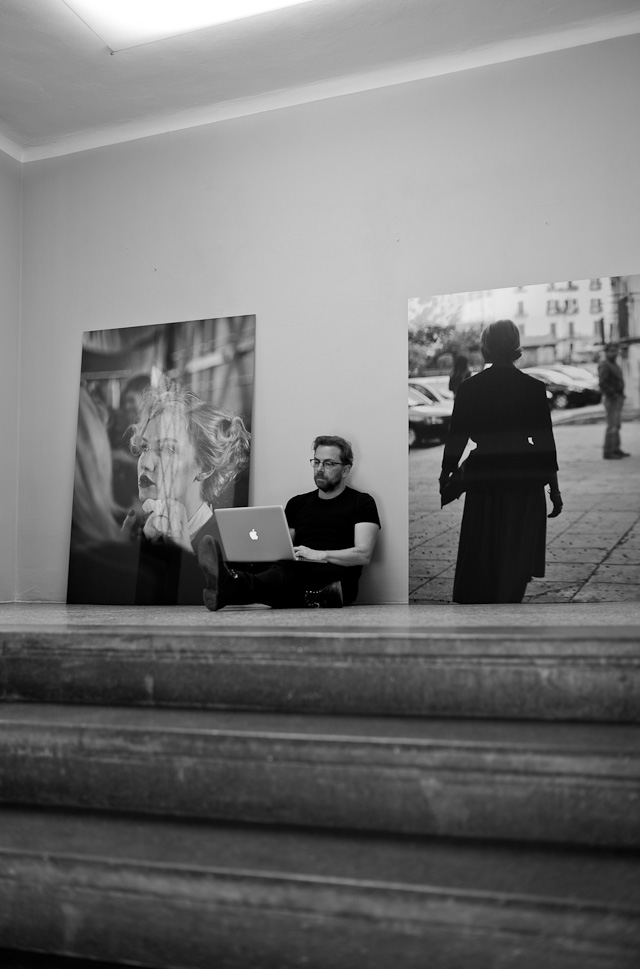
Sitting between MAKE UP and DIOR GIRL, two large prints made as one-off limited silver prints on aluboard for the exhibition, numbered 1 of 1.
So as I have been preparing the WE THE PEOPLE exhibition in Salzburg that opens tonight, here is what I have learned so far
1) No image is an island: You want to have a personal relation to the image. You may know the artist, or you were there when it was being taken. Or you have read about the picture and know the story behind it. Or you have been, where the picture was taken, or it shows somebody you know or reminds you of a place.
It's good training in judging your own work to look at and buy other work. The art I have and continue to buy is a print my daughter and I stumbled upon and liked, so it continues to be our mutual art print. When I look at the image, I think of my daughter and our shared enlightment and our decision to buy it.
Some drawings are from young artists, where I sort of imagine their future career and want to be part of it. Another photo I have hanging, I bought because I knew the photographer and the city it was shot, Tokyo. But then after having bought it, I noticed it was Shanghai and not Tokyo. But I decided to keep it as I had also been to Shanghai!
Some of the art is by people I have met before or after, and it all builds a part of the experience. If you buy a piece of art and then meet the artist and learn he's not a nice person, the art will go down in your evaluation.
This also works with other things in life. The buying experience in luxury stores build a part of the brand and the product you buy, is not just the product but also the experience of the store, the wrapping and the service. And some ice cream simply tastes better if you are with the right people and the sun is shining.
| |
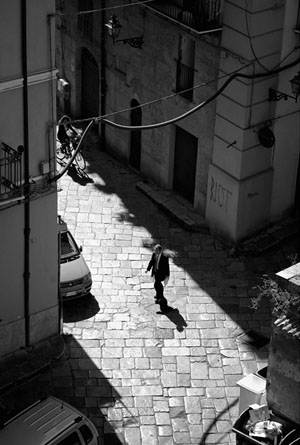 |
| |
One of the 68 images in the exhibition that is good example of how people see differently
First of all I was having a cigarette on the terrace early in the morning when I noticed the light. So whilst sitting in my chair and smoking I pointed my 90mm Leica Summarit-M f/2.5 down and shot a series of frames to get a satisfying rythm of people passing by. I might have hoped for a Vespa coming by or something special and felt I didn't really get it. I also felt it was not a real picture but just a silly snap that could at least be used to test the focusing of the lens.
But later I decided to select one of the images, and people liked it. Later some pointed out that the "riot" written on the wall (that I had considered removing in Photoshop because it annoyed me) was really interesting. The cables also annoy me, but perhaps some like the picture because of them. I don't know.
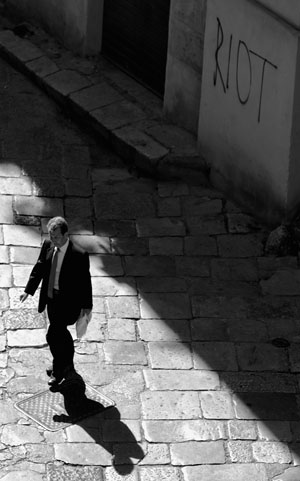
You could explain to death why it is a good picture. All I have to know is that some people like it and some don't get it. But of course I pay attention to what people say as every image is a learning curve meant to improve your future images.
But I think your visual education is something you build and understand without words, expressing things through shapes and motion. The same way you learn to draw; you wouldn't analyse to put in words how you do it, you just know how to move your hand.
|
| |
|
2) The image becomes part of you. Sometimes you discover more in an image, or something else, than what you first saw. I have a drawing of people in a library where you keep finding new people and new details.
Or the image and colours change like an ocean when the outdoor light changes. To see this quality in one of your own images can be hard; often you made it with an idea in mind, and then others might see things different and like the image. Maybe you were trying to capture something and failed. And you failed to see you got something else.
But others see it (which is why you should always pay attention to what people see in your images and not take it for granted that they see the same error in focusing as you noticed but perhaps notice two aligning shadows and a face in the background. So what is for you an image that shows that your camera is back-focused for others is a story of a face behind bars. Or something).
In the images for the The Salzburg Collection a friend pointed out that many of the images made him want to know more. Like in advertising where you can make come-on or teasers that make people want to know more. But I never made the images that way, they just happen to be frozen moments, and as it turns out, it makes the viewer curious about the circumstances, where it was, what happened before and what happened after. And as the viewer don't know, he or she will have to continue to fill in the gaps and build their own story.
This way you, the viewer contributes to the art, and thus it's not just my image, but yours.
A good example of how an image becomes a piece of art is the "Klein Blue" painting by Yves Klein at the Guggenheim Museum in New York. It's a large painting that is simply painted blue from corner to corner.
Yves Kein made and patented a blue color "International Klein Blue" which is just amazingly blue, and when you stand in front of the image, you can't really tell if it is blue dust, paint or if there might be more to it than "just a frame of blue paint."
In a way the image invites you to participate, and as presented at the Guggenheim (and not at the back of a garage or on a default location in a kindergarten), the experience of finding it in the museum, looking at it with other wondering museum guests contribute to the picture. In a way, Yves Klein added blue - you add the rest.
3) Frame it and be amazed. An image works differently when blown up and framed. Some very nice pictures that might have been very popular on the web and sold many times for editorial use simply dies when they are blown up. They are dull in the context of a frame on a wall. Other pictures that nobody really noticed on Facebook or on a website become valuable labyrinths of intriguing information when blown up and framed on wall.
4) Your view changes over time. It's interesting how I may select a series of photos one day, and then a week or one day later clearly see how some images became a more valuable part of the collection whilst others simply now look misplaced.
We all have images on our walls, or things standing around, or even books on the book shelf, that we once were very enthusiastic about. And now don't notice anymore.
Sometimes external events change the value of an image, for example images of the Twin Towers in New York took on a new dimension after September 11, 2001.
5) Some buy as an investment. It's like cameras; some use them, some collect them. The good thing about art is that it seldom goes down in price. In worst cases the price stays the same forever, but for most active artists, the price raises as popularity goes up. And what really drives prices up is scarcity. If Picasso existed in unlimited numbers, everyone could have one. But as it is, he only made one painting and that's why the price is high. When the artist dies, the pieces made become rare because no more originals can be done. Of course the market has to agree it's value of having, else there would be no point in wanting it. For the Salzburg Collection we decided starting at a very friendly price range . (hint: If you want to make a good deal, contact the Leica Galerie Salzburg for overview of limited signed prints available).
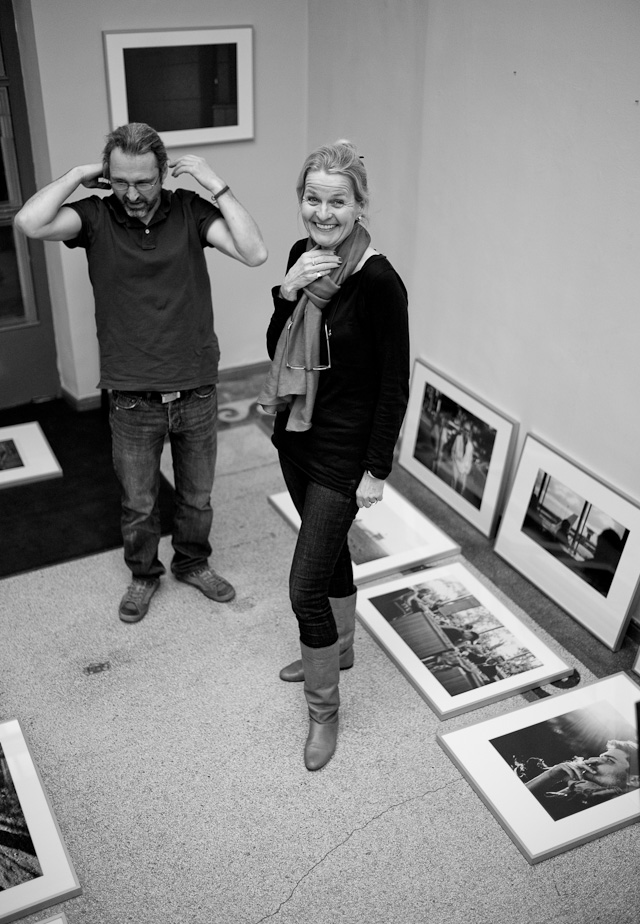
Karin Kaufmann runs the Leica Galerie Salzburg and has a good eye and has been an invaluable help. In two minutes she can decide what else would take weeks to figure out!
6) Listen to your gallery owner. He or she has the experience about what works, how many editions there should be, if your idea of a theme would work and all that. So think in doing a presentation that communicates the idea to the gallery owner, and then let him or her look over it and have their say. They know from experience, and that is invaluable.
Buy "The Salzburg Collection"
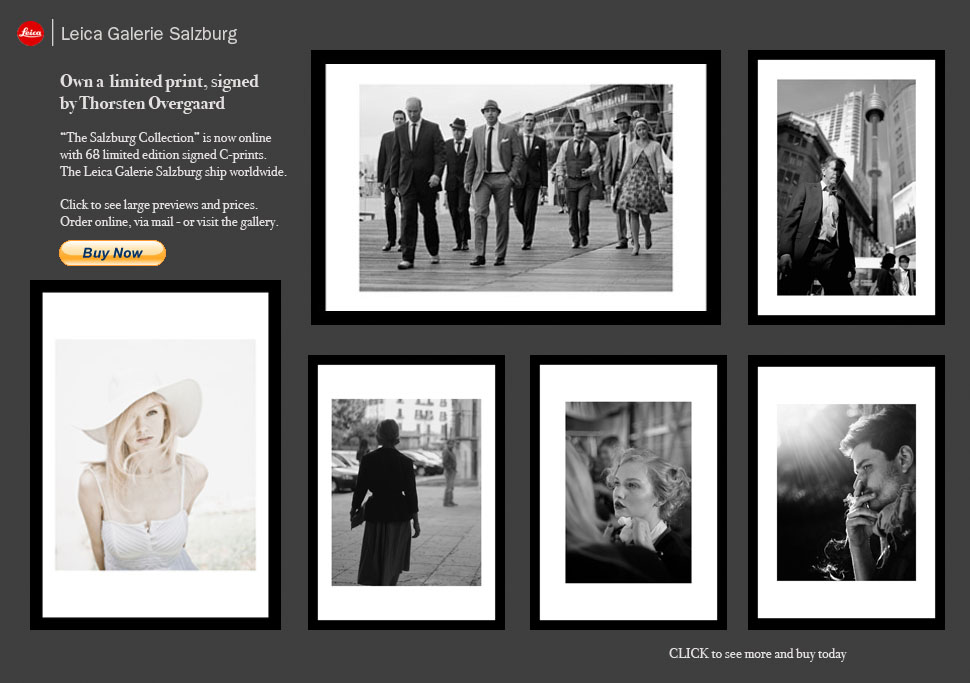
7) Always wear a camera. As I always say, and now, I say it again. I am astonished about how many of my exhibition photos are photos I made on a late evening when having dinner in a cafe in Berlin and happened to snap a photo of the couple at the next table. Or trying to do something else in Italy when I stumble over a motive that I didn't quite get, but then got something else that works on a wall. Or the photo I got when getting a coffee and didn't expect to take a photo. Or an image I took while waiting for a airport shuttle in Tokyo, sweating from moving too many suitcases too fast; yet with the camera hanging by my side.
Very few of my images in this exhibition are photo sessions where the photography was planned as an assignment. The majority are just ... wearing a camera, and ready to use it.


![]()
